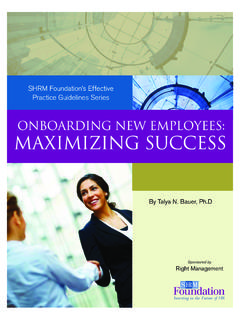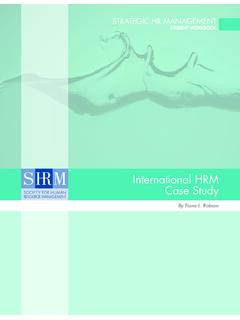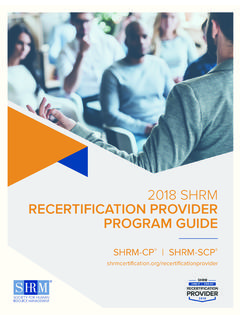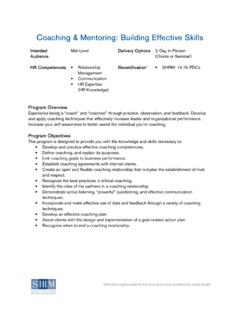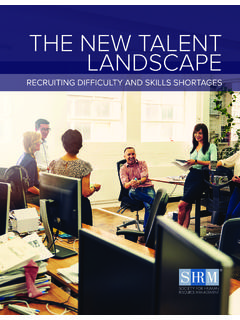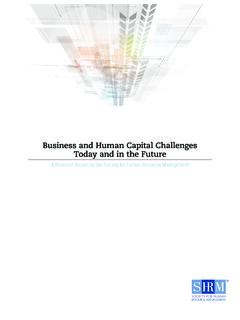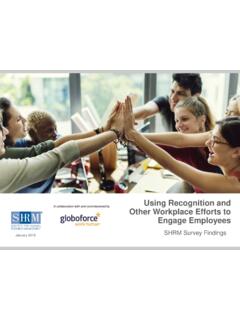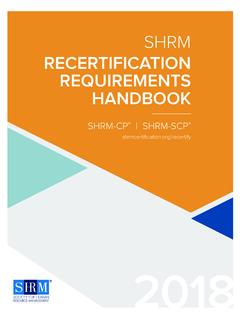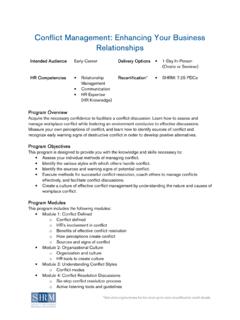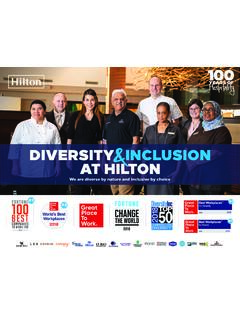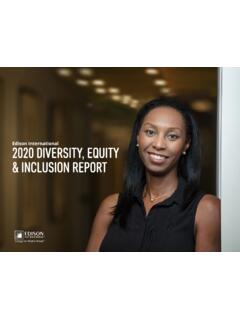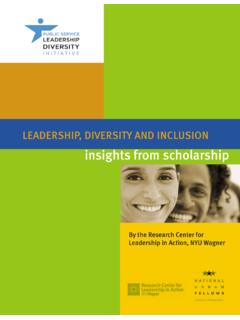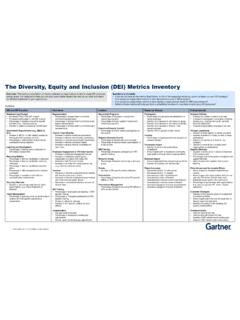Transcription of Global Diversity and Inclusion - SHRM
1 Global Diversity and InclusionPerceptions, Practices and AttitudesGlobal Diversity and Inclusion : Perceptions, Practices and Attitudes 1 Global Diversity and Inclusion : Perceptions, Practices and Attitudes 1 Global Diversity and Inclusion :Perceptions, Practices and AttitudesA Study for the Society for Human Resource Management (SHRM)Conducted by the Economist Intelligence UnitTABLE OF CONTENTS3 Background5 Introduction7 Executive Summary7 Sidebar: Who took the survey?9 Part I: Opportunities from Diversity9 Workforce Diversity and Inclusion in multinationals: Facts and trends10 Sidebar: How diverse is your country?
2 12 Sidebar: Key fi ndings from the Global Diversity Readiness Index: Top countries13 The business case for Diversity17 Supplier Diversity : The next frontier21 Part II: Challenges of Diversity21 Divergent paths taken to reach the same goal22 Internal resistance to Diversity efforts24 The quota issue25 Sidebar: Key fi ndings from the Global Diversity Readiness Index: Top regions27 Part III: Best Practices27 Management structures28 Metrics and rewards29 Internal communications and training30 External outreach33 Part IV: Regional Characteristics33 North America: Embracing change33 Western Europe: Ladies fi rst34 Asia/Pacifi c: Diversity the natural way39 Middle East: Local talent41 Conclusion43 Chart and Table Index45 Appendix I: Global Diversity Readiness Index: Methodology, Results and Findings63 Appendix II: Participants in Qualitative InterviewsGlobal Diversity and Inclusion : Perceptions, Practices and Attitudes 3 More than ever, businesses, governments, non-profits and other organizations are finding it necessary to adopt a Global mindset in order to remain viable and rel-evant in today s Global marketplace.
3 As or-ganizations recognize the importance of developing greater cross-cultural compe-tence, Diversity and Inclusion practitioners are often at the forefront of this work. This makes sense, as these professionals have long been engaged in helping individu-als and organizations manage and leverage difference in ways that allow people from all backgrounds to hear and be heard, un-derstand and be understood, and work together productively. And some will sug-gest that one s national culture is the most powerful differentiator there is, greater than ethnicity, gender or yet, Diversity and Inclusion practitio-ners are often caught in the same conun-drum as those they serve, because like every other facet of business the concepts of Diversity and Inclusion themselves often mean very different things in differ-ent countries around the 2008, the Society for Human Resource Management (SHR M) commissioned the Economist Intelligence Unit (EIU), a sub-sidiary of The Economist Group, to con-duct an International Study on Diversity and Inclusion .
4 The study was launched to provide a deeper understanding of Diversity and Inclusion issues on a Global scale, and to offer insight into Diversity and Inclusion best practices worldwide. This groundbreaking study included sur-veying over 500 executives and inter-viewing 40 of them. In addition, the Economist Intelligence Unit researched the Diversity readiness of 47 different countries to create the Global Diversity Readiness Index (see Appendix II for more information). This report details the find-ings of both the research and this ground-breaking new the publication of this research, SHR M will release the Global Diversity Readiness Index as an online tool at ; incorporate the find-ings into future programming, includ-ing the SHR M Diversity and Inclusion Strategic Leadership Program; and use the knowledge gained to inform its Global business strategy moving Diversity and Inclusion : Perceptions, Practices and Attitudes 5 More than half a century ago, author Sloan Wilson described a world of corporate con-formity in a popular novel, The Man in the Gray Flannel Suit.
5 A collection of empire-builders and yes-men all with similar backgrounds and ways of thinking creat-ed a dreary culture of sameness that nearly led to a disastrous decision in the execu-tive world, increasingly, is disappear-ing. Today, just as national boundaries are eroding in the Global village, so are cul-tural and gender barriers weakening in the Global workforce. The concept of work-force Diversity is no longer an abstraction; it is part of everyday life in many countries in the developed world. Driven by a need to compensate for talent shortages and compete in an increasingly diverse market-place companies are extending their re-cruiting and promotion efforts to groups that traditionally were under-represented or not present at all.
6 Yet in many ways the journey has only be-gun. Even in countries with diverse work-forces, the members of demographically dominant groups tend to have more influ-ence and face fewer barriers to recruitment and advancement than the newcomers. There are still countries in which the idea of workforce Diversity has made few in-roads, either because of cultural barriers or the lack of a critical mass of representatives of diverse groups. Companies have come to understand that different demographic groups think and communicate differently, and that these cultural differences must be understood by all concerned before new-comers from diverse backgrounds can be truly integrated and included in a compa-ny s Diversity and Inclusion looks at the advantages that Diversity and Inclusion bring to a company, as well as the chal-lenges inherent in creating and managing an integrated workforce.
7 Since the nature of the journey and the degree of progress to date differ in each region, the study focuses on regional and cultural differenc-es to managing and valuing Diversity , as well as the best practices that tend to pro-mote Diversity and Inclusion study is based on a quantitative online survey of 546 senior executives of compa-nies worldwide, which was conducted in July 2008 by the Economist Intelligence Unit on behalf of the Society for Human Resource Management (SHRM). The con-clusions also draw on more than 40 in-depth interviews with senior executives in North America, Europe, Asia and Latin Diversity and Inclusion : Perceptions, Practices and Attitudes 7 Workforce Diversity and Inclusion is a concept that appears to have taken hold in companies worldwide.
8 According to a survey conducted by SHR M, 55% of re-spondents say their organizations strong-ly promote Diversity and Inclusion . However, the interpretations of the phrase and the methods used to achieve this goal vary widely among companies and regions. In companies with the most successful Diversity programs, the impetus and tone emanate from the most senior ranks of the organization. Sixty percent of respondents to the survey say the main advocates for Diversity and Inclusion in their organiza-tions are the CEO and top management, followed by heads of HR (42%). Most companies recognize that Diversity and Inclusion are closely linked; Inclusion helps to ensure that employees from di-verse backgrounds are able to contribute, remain with the company and differing regional interpreta-tions of Diversity and the variety of cul-tural sensibilities involved, multinationals tend to leave much of the implementation of Diversity programs to managers at the local and national levels.
9 The degree of de-centralization tends to vary with the par-ent company s nationality. For example, North American companies take a more centralized approach, whereas Western European and Asian firms tend toward a more laissez-faire attitude in Diversity -related most parts of the world, the main fo-cus of Diversity efforts is on hiring and promoting women. The major reason for this is that women, who make up 50% of the population, represent a large, un-tapped (or under-tapped) resource, which companies will need in the future as Baby Boomers begin to retire. Women are also comparatively easy to integrate into or-ganizations, since gender issues aside they typically have grown up in the same country as their male colleagues, and hence tend to share the prevailing cultural norms.
10 Employees from minority ethnic, national or religious groups may present more complex issues such as cultural back-ground and styles of thought. Again, the survey findings back this up: when asked to name up to three groups that should be better represented in the company, a whopping 79% of survey respondents cite women, followed by 46% naming peo-ple over 50 years of age and 39% ethnic arguments for greater Diversity range from complying with equal-opportunity laws to obeying moral imperatives to serv-ing the company s financial interests. The latter argument the business case for Diversity has several main components.
